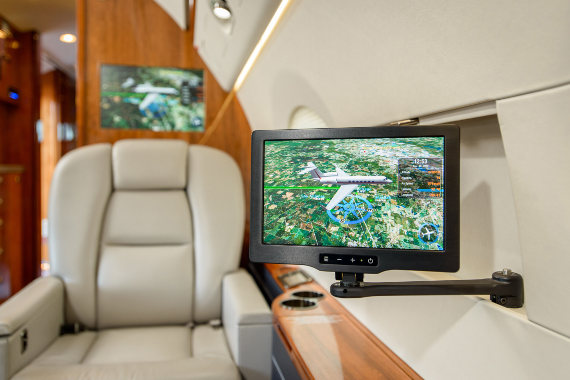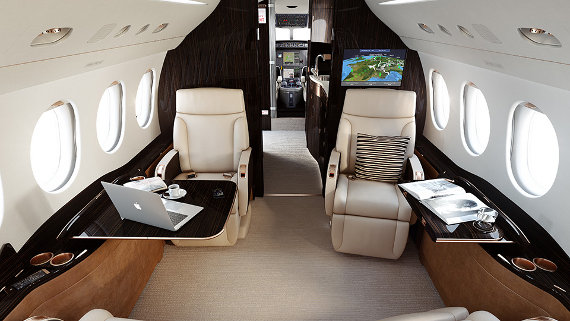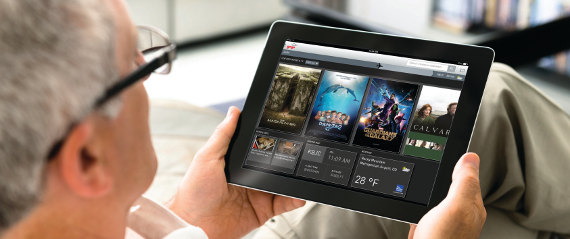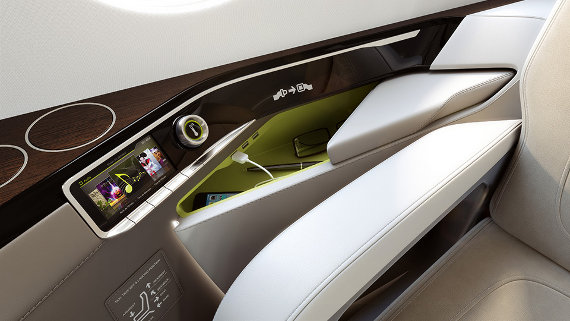Today's business jet aircraft cabins provide high definition video, surround sound audio, full color spectrum mood lighting, and complete cabin control right at your fingertips. Business jet passengers can literally have their home theater or office functionality from take-off to touchdown. But what are the things to think through in either a new aircraft or if you're looking at a used plane?
CMS & IFE Defined
Cabin management systems (CMS) generally cover utility control of various cabin environmental functions such as temperature, lighting, galley services, waste water, and window shades. Plus In-flight Entertainment (IFE) which includes audio, video, interfaces to personal electronic devices, access to media content storage (audio & video files), satellite TV, and moving map equipment as well as access to long-range satellite communications and internet connectivity.
Both CMS & IFE systems have dedicated or fully integrated controllers which include devices such as Apple iOS and Android based tablets and smart phones, as well as at seat, touch-screen controllers, with screen sizes ranging from two -to- ten inches.
Ask the boss if it's okay to fly without these systems functioning, even though most aren't required for flight, and prepare for significant feedback........or worse. Cabin systems today are considered go-no-go items by many CEOs & High Net Worth travelers.

Core Technology & Trends
Several large CMS and IFE suppliers design, sell and manage fully integrated systems addressing the complete cabin in-flight experience. In addition there are multiple suppliers of individual components that may or may not be integrated with the existing cabin systems.
CMS and IFE systems are generally designed using one or perhaps all three of the following backbone technologies - Ethernet, Fiber Optic, and Wireless - in combination with equipment that integrates all IFE cabin functions.
"Wireless is really starting to hit, especially with the latest 802.11ac standard" said Justin Dye, Product Manager at Honeywell Aerospace. "Installers really like wireless because it's quicker to install and users like it since they can bring their own devices" he continued.
In the auto industry, car manufacturers have stopped building their own infotainment software and are starting to standardize on platforms from QNX (Blackberry), Android and Apple software. But in aerospace there is no software platform standardization to date. "We are really focused on the user experience and matching the sort of interfaces people see in consumer electronics" stated Justin Dye.
Virtually none of the CMS/IFE suppliers build 100% of their own custom designed components. Instead they primarily draw from commercial off-the-shelf sources. In many cases the system components and subassemblies are integrated and repackaged consumer electronics. With the short lifespans of current consumer electronics, it becomes an ongoing process to stay ahead of system obsolescence and keep up with consumer expectations.
At the heart of these systems is a smart switch or router. These are used to control full audio, HD video including streaming and an array of information services, including use of your personal phone as if you were on the ground. As technology has improved, the latest routers are much faster and more capable than older generations. Many equipment designers are integrating (previously separate) devices into one box to save weight and space. Of course electronic advancements and miniaturization has enabled many new designs.
Overall the CMS timespan is very different to the rest of aerospace in that it's a much shorter lifecycle. Aircraft engines can last for decades when they are correctly maintained, but a CMS can become quite dated within a few years. For leading indicators of where some of these platforms are likely to go in the future you can look at the sort of things that are happening in connected automobiles and consumer electronics.
"Customers are requesting that what they use on the ground, they want to use in their plane" said Jerry Sanders at Standard Aero. "They want streaming video, to be able to use personal carry on devices and they want to control the CMS with their personal devices".
Suppliers
The major suppliers include:
- Honeywell, with their Ovation Select system
- IDAIR, a joint venture between Lufthansa and Panasonic, generally work on larger VIP aircraft
- Collins Aerospace, with their Venue system
- Flight Display Systems

Video
Aircraft delivered only 5 years ago were outfitted with standard definition video equipment. The latest platforms are all digital and offer hi-definition (HD) blu-ray players and streaming videos. The very latest migration is from "spinning discs" (such as DVDs and blu-ray) and instead going to large 1TB+ solid state drives which can store and provide access to thousands of movies. The monitors and screens can be as large as your cabin space allows, or can be as small as your own personal carry-on device.
This transition to HD and digital brings up a couple of key things in aviation. On older aircraft the existing wiring is not capable of transmitting digital HD signals, so it brings in the need to rewire an aircraft. In addition the move to digital brings digital rights management (DRM) into the equation; basically the movie industry wants to protect content and control how many devices a movie is watched on. This isn't an issue in a home since the blu-ray player typically links to just one TV and everyone is watching one movie on one big screen. In an aircraft if there are multiple screens you will need authorization to redistribute a movie to multiple monitors at once, so the blu-ray players and the monitors need to be able to talk to each other. The latest CMS/IFE systems are designed to satisfy content security and DRM.
Some of the latest systems, such as the Skybox from Rockwell Collins and the Gogo Vision UCS 5000 can deliver movies, TV episodes, news, destination weather, moving maps and flight information.
The Skybox integrates and extends the popular capabilities of Apple's iCloud, Home Sharing, and AirPlay. You can stream digitally-protected Hollywood movies and TV shows from Skybox's on-board Apple iTunes library.
With Gogo Vision a full library of the best movies and TV episodes, can be searched, selected and watched from laptops, tablets, and iPhones for a content subscription fee.
Steve Elofson at Duncan Aviation has seen several planes incorporating video from cameras on the aircraft. These cameras can be located on the tail, they may be belly cameras (which the crew use to see images of the landing gear), and they may be glare-shield cameras, so that the people in the cabin can see the pilots point of view. Some new aircraft have some of the cameras pre-installed or they can be installed at a later date.
Some aircraft also have a live satellite TV feed which runs through the CMS. Although Steve Elofson sees this going out of fashion because i) it is not HD, ii) it is somewhat expensive, iii) you lose the signal over oceans, since it is reliant on satellites that provide the land footprint and iv) it is more popular for people to bring their own content or use the on board content libraries.

Audio
The most up to date aircraft offer a full surround sound, for instance with 16+ speakers strategically placed throughout the cabin, and digital amplifiers ensuring a home theater like experience. At the high end you can easily spend $200,000 purely on the audio piece of your IFE system.
"On older planes speakers were often close to people's heads, but the latest audio systems give more of a surround sound, with multiple speakers throughout the cabin," said Olivier Langeard of Dassault Aircraft Services.
One of the leaders in this arena is ALTO Aviation, whose founders came out of Bose Corporation. ALTO designs and manufacturers cabin audio systems, including custom amplifiers, entertainment loudspeakers and subwoofers. They will even perform customized onsite cabin audio tuning to optimize sound characteristics with your cabin floorplan. As part of this tuning, an acoustic engineer acoustically maps the full interior of your aircraft and adjusts the digital amplifier and speaker locations to define the performance characteristics of the system.
Lighting
The cabin lighting is all controlled by the CMS. Color lighting is becoming more common and affordable with the introduction of lower cost color LEDs. The most up to date CMS's have presets and color wheels for instance, to create mood based lighting.
"The color keeps on getting better and better and is now more uniform than the original LEDs" said Steve Elofson. "We are even seeing some planes change out the original LEDs from 10 years ago, because the color is so much better now."
Another advantage is that LEDs last for the life of an aircraft, so there's no more need for replacements for burnt out incandescent bulbs.
New Aircraft
If you are buying a new plane, your choices are limited to suppliers the OEM has already qualified on their aircraft. You may have some feature choices, but customization of configurations and graphical user interface (GUI) will be limited. Not all OEM systems are created equally. Some choose to perform their own integration and overall system design using 3rd party suppliers. Others rely on a single primary supplier to perform system design and integration work, prior to hardware delivery to the OEMs production line for installation during aircraft manufacturing processes.
"Options include the number and size of monitors," noted Olivier Langeard of Dassault . "In the Falcon 8X you can have up to a 32' monitor, but this basically takes away a seat due to the size."
Be more aware, if you are looking at an aircraft manufacturer that has chosen to design and integrate their own, home grown CMS. Keeping up with obsolescence issues and revising Aircraft Type Certifications is a major undertaking and significant overhead cost driver. "From our perspective, CMS/IFE design, maintenance, enhancements, and introduction of new solutions is better left to those businesses that specialize in the technology" said Paul LaFata, President & CEO of Jet Support 360 Advisors.
Jerry Sanders of Standard Aero suggested three key things to consider in looking at new aircraft:
- What CMS does it have and does this meet your current needs and requirements?
- What is the supportability? are OEMs the only folks who can work on it or are Authorized Service Centers (ASC) approved to maintain and upgrade it?
- What is the likely cost of expandability?

Preowned Aircraft Upgrades
If you're upgrading your existing CMS/IFE system to new technology, there are several considerations:
- Is your priority productivity, inflight enjoyment & convenience, or "I want the best technology on the market?" In other words is your aircraft a work platform, used for family travel or a bit of both.
- Define a specification of what your desires are, and understand what you need to meet your operational requirements. Most CMS/IFE system retrofits allow a wide range with respect to customization of equipment and look and feel (GUI). "This type of equipment is cool and high tech, but proceed with caution. Keep in mind the rules governing what you can install in your aircraft are far different than the options available for your home," advised Paul LaFata.
- If you're refreshing your interior, this is the ideal time to replace old and obsolete equipment.
- Sideledge woodwork is astronomically expensive to modify or replace when adapting controllers and various media docks in the cabin. Consider all alternative options including wireless controllers unless the interior is due for a complete refresh.
- Consider a partial refresh if the existing system meets most of your current needs.
- Prioritize your "gotta haves" and your "wanna haves" and see what your budget will support.
- Down-time is often a key element. Can you add a CMS/IFE refurbishment in coordination with other scheduled maintenance? Or would you consider bringing your plane down for the sole purpose of a CMS/IFE installation?
If you only have limited time available to upgrade your existing system, consider a provider that can perform a phased installation, thereby getting you back in the air as soon as possible, by enhancing your system one or two steps at a time.
Olivier Langeard at Dassault said "We try and steer people to the same standard as our brand new aircraft, since the technology is tested. This also gives them the full support of our vendors and the overall support network."
Olivier provided some broad examples to replace existing systems:
- For an "HD overlay", keeping as much of the backbone as possible, the price range is likely to be $250k - $350k
- If you want to replace the switching as well, the price is likely to be $350k - $400k
- If you go the whole way, with multiple monitors, blu-ray, change the controls so that you need to redo the woodwork because the cutouts are different, then the price can go to $1.2m - $1.3m
Olivier noted that at the higher end of these prices, if a client has just invested in upgrading their cockpit, they sometimes want to wait before upgrading the cabin and CMS.
As a comparison Jerry Sanders of Standard Aero provided a couple of examples for approaches:
- For an "HD Overlay" with a "cabin refresh" including:
- Install enough to keep the current controls in the airplane, so use some of what's there already
- Put in an HD switching unit
- Change the monitors
- Sometimes add streaming
- Sometimes, but not always enable a tablet interface
The likely costs are $200k-$500k and plan on this taking 21-30 days
- For a new, complete CMS from scratch:
- With streaming
- With a tablet based UI
The likely price is $500k-$1m and will take from 60-90 days, with the price dependent on what you want and how you use it. This will give you more usability and longevity
At Duncan Aviation, Steve Elofson gave a similar estimate of 8-12 weeks in total downtime for a complete CMS package including a cabin upgrade. Duncan ideally also like 8-12 weeks of lead time to allow for planning and integration considerations.
The most common time to upgrade the CMS is when the cabin interior is also being replaced. A full CMS replacement will involve touching the woodwork and the panels, so it makes a lot of economic sense to do this as part of a cabin upgrade. If you opt for an HD overlay and cabin refresh this is less invasive and does not affect the interior as much, so doesn't need to be done with a cabin upgrade.
"In assessing these projects, some people also compare the cost to the value of the aircraft, and don't want to over upgrade their aircraft" advised Steve Elofson.
"Whatever you decide, insist on a demonstration, preferably on an aircraft, of an actual installed system" said Paul LaFata. "There is no better way to evaluate features and performance, and overall benefits and enjoyment you'll derive from your investment, then to experience it first-hand" he continued.
As you might expect Paul Lafata of Jet Support 360 Advisors told us "Hire a 3rd party professional to help with specification preparation and assessments," and then with insight he added "ensure you understand completion center and MRO relationships with equipment suppliers, including any existing purchasing incentives. Make sure you have a full understanding of what you're getting into before signing the contract."
Buying a Used Aircraft
If you're buying a used aircraft with an existing CMS, it is important to evaluate the overall condition and suitability of the installed system to meet your needs.
Problems with in service equipment can be significant, and expensive if appropriate due diligence is not performed before closing the deal. CMS/IFE equipment can be a huge source of owner dissatisfaction – to the point that the aircraft is disposed of (there are several stories from the cockpit on this point). Make sure your CMS/IFE provider has a robust system and worldwide technical support.
Look at the age of the CMS and assess whether you can refresh it or will you need to replace it, using the example prices above to give you an idea of costs.
Overall
As you can see the latest CMS/IFE systems offer a lot of useful features. Whether you currently own an aircraft or are looking to buy or upgrade one, the key things to think through are:
- Where do we want to use this asset? for example are you using it worldwide or just in the US. This impacts the satellite connectivity and the air to ground network and so can affect your productivity, entertainment, or the updates for your stored media database.
- What requirements do you have, and what problems are you trying to solve? For instance do you want data connectivity on the aircraft, do you want satellite TV.
- Who uses the plane and how do they use it - business and/or pleasure?
- Do you want just phone connectivity, or phone and internet?

